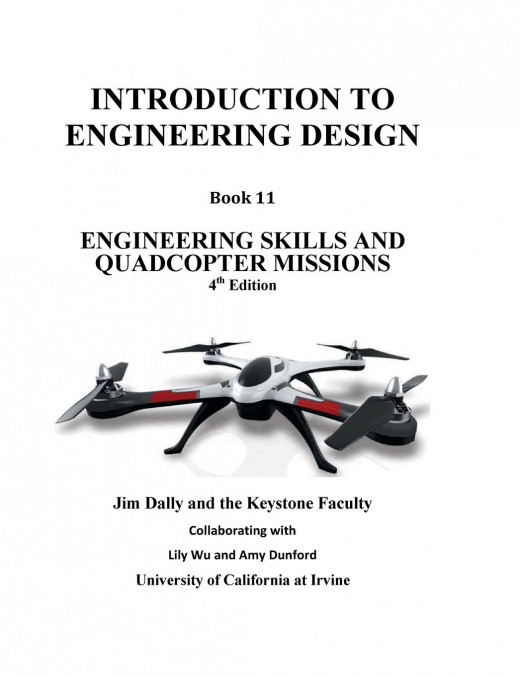
Jim Dally
This book is the fourth edition of the eBook edition of the eleventh textbook in this series: Introduction to Engineering Design. Jim Dally, working with College House Enterprises, LLC and faculty members in the Keystone Program within the Clark School of Engineering, has prepared ten previous textbooks in this series—a new one almost every 18 months. These books are written for the first-year engineering students of the University of Maryland at College Park, the University of Nevada at Reno and the University of California at Irvine. This version dealing with Quadcopter Missions has been prepared for the University of California at Irvine. The design, build and testing of a hovercraft model, described in Book 9, was such an interesting and challenging project that it was used for twelve semesters with approximately 8,000 students at the University of Maryland and more than 6,000 students at the University of Nevada at Reno where it is still in use. This eleventh book in the series covers the design and build of a quadcopter, as well as many other topics offered to first year students in an introductory course. Near the end of the first quarter a student operator flies the quadcopter under radio control (RC) into a netted arena and competes in a time controlled event involving landing and takeoff from platforms in a specific sequence and flying through a small gate. During the second quarter, the design teams fly their quadcopter under radio control, but deliver cargo to specific sites under autonomous control.The textbook is used to support students for two quarters involving two related projects involving a quadcopter. Some of the material may be covered in lecture, recitation or in a computer laboratory or a model shop. Additional material is covered with reading assignments. In other instances, the students use the text as a reference document for independent study. Exercises, provided at the end of each chapter, may be used for assignments when the demands of the project on the students’ time are not excessive.The book contains 20 chapters that cover many of the topics that first year engineering students should begin to understand. To facilitate referencing the various chapters we have divided the textbook into three parts: Part I includes eight chapters that contains most of the technical content required for the students in the fall quarter. We have included Chapter 7 on Team Development because student design teams often have difficulty functioning smoothly. We have also included Chapter 8 on the Engineering Profession that provides information to support the presentations of the representatives from the College’s Engineering Departments.Part II contains the content for the fall quarter, during which the students are assigned an autonomous cargo delivery mission. In addition to the mission oriented content, we have added Chapter 11 on 3D Printing and Chapters 12 and 13 on Portfolio Design.Finally Part III includes seven chapters that contain content often covered in more traditional Introduction to Engineering courses. We recommend that students refer to these chapters, as they consider a career in Engineering. Of particular importance is Chapter 14 titled A Student Survival Guide, which provides a systematic approach to successfully completing your engineering studies. We also strongly recommend that you read Chapter 18 on Ethics, which is focused on issues that arise in engineering. 3